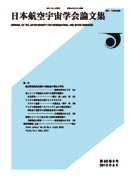巻号一覧

35 巻, 403 号
選択された号の論文の6件中1~6を表示しています
- |<
- <
- 1
- >
- >|
-
西 周次1987 年 35 巻 403 号 p. 363-369
発行日: 1987/08/05
公開日: 2010/12/16
ジャーナル フリーPDF形式でダウンロード (15325K) -
高草 孝夫1987 年 35 巻 403 号 p. 370-378
発行日: 1987/08/05
公開日: 2010/12/16
ジャーナル フリーPDF形式でダウンロード (8180K) -
早川 義彰, 仁部 比斗史1987 年 35 巻 403 号 p. 379-388
発行日: 1987/08/05
公開日: 2010/12/16
ジャーナル フリーUncertainty in a gyro design means unpredicted problems in design phase, and this will introduce uncompensated errors which must be charged to the gyro. Uncompensated errors in gyros are as follows. (1) Drift instability, (2) Scale factor instability, (3) Temperature coefficient of drift and its instability. As an uncertainty or instability of gyro output is related to not only a design but also manufacturing as causing a change in the location and a randomly substance of adhesive, etc, it is difficult to make clear the level in design phase. However, it is important to find out the principles governing parameters for instability or uncertainty of gyro output. Then, a Day-to-Day stability and a Temperature Coefficient of G-insensitive Drift for TDGs was measured, and furthermore, In-phase spring rate, Quadrature spring rate and offset angle which consist of G-insensitive drift of TDG was measured. As a result of these testings, it was found out that the governing parameter for instability or uncertainty of TDG G-insensitive drift was mainly dependent on offset angle variation. This conclusion will be effective to introduce more accurate TDG in design and fabrication.抄録全体を表示PDF形式でダウンロード (6790K) -
小早川 命, 中尾 雅弘1987 年 35 巻 403 号 p. 389-398
発行日: 1987/08/05
公開日: 2010/12/16
ジャーナル フリーIn order to investigate the flow field around the ATP through numerical methods for its optimal design, 3D-Euler equations are most prominent. The flow field around counter rotating propellers in advancing 0.8 Mach is obtained. Two spaces including front and rear blades are solved separately. The interaction between both blades are taken into the calculation by the connecting surfaces. The noniterative implicit ADI scheme is used in order to solve Euler equations. The periodic steady and averaged steady solutions are obtained. The latter is simplified by averaging the variables at the connecting surface. This shortens the calculation time to one-third comparing with the periodic steady analysis which simulates the relative motion of the blades exactly. Numerical calculations are performed for two counter rotating ATP's with SR-1 and SR-3 blades. Both results show that they are similar with each other, and the propeller efficiencies increase comparing with single rotating ATP with same blades.抄録全体を表示PDF形式でダウンロード (16095K) -
井上 建二, 中村 孝1987 年 35 巻 403 号 p. 399-400
発行日: 1987/08/05
公開日: 2010/12/16
ジャーナル フリーTwo things to be added to a previously published paper on the calculation of the transonic potential flow through a two-dimensional cascade are stated. The first is the procedure of calculation to obtain the solution in which a given point on a blade is a stagnation point without giving the downstream condition. The second is the relation between the force acting on a blade, the distribution of pressure on its surface, the circulation around it and the up- and downstream conditions.抄録全体を表示PDF形式でダウンロード (102K) -
橋本 孝明1987 年 35 巻 403 号 p. 401-404
発行日: 1987/08/05
公開日: 2010/12/16
ジャーナル フリーA design method of the cascade for a shock-in-rotor supersonic axial-flow compressor is presented. The inlet flow is uniform and satisfies simplified radial equilibrium. The flow just before the normal shock is uniform and satisfies simplified radial equilibrium. The supersonic portion between the inlet and the normal shock is designed by using the method of weak wave. In the subsonic portion the flow is quasi-axisymmetric. The shape of mean streamline is assumed to be circular arc. The passage walls are composed of circular arcs. A two-dimensional supersonic cascade which is designed by the method in this report includes the three-dimensional effect by taking into account radial equilibrium conditions.抄録全体を表示PDF形式でダウンロード (2166K)
- |<
- <
- 1
- >
- >|